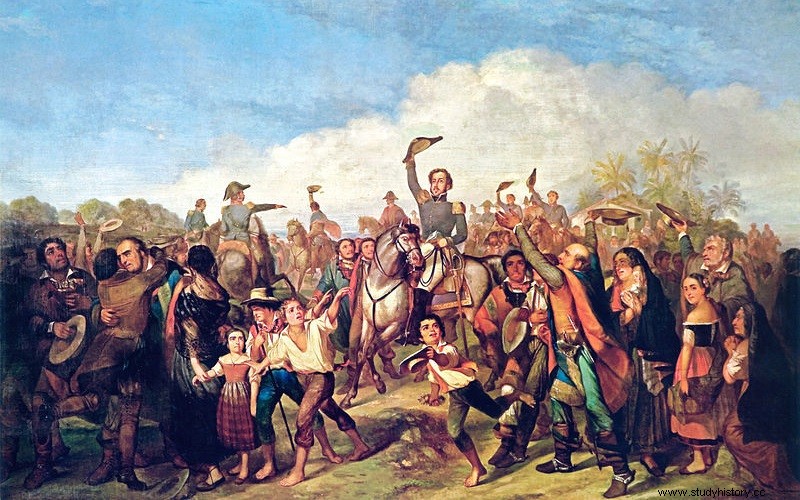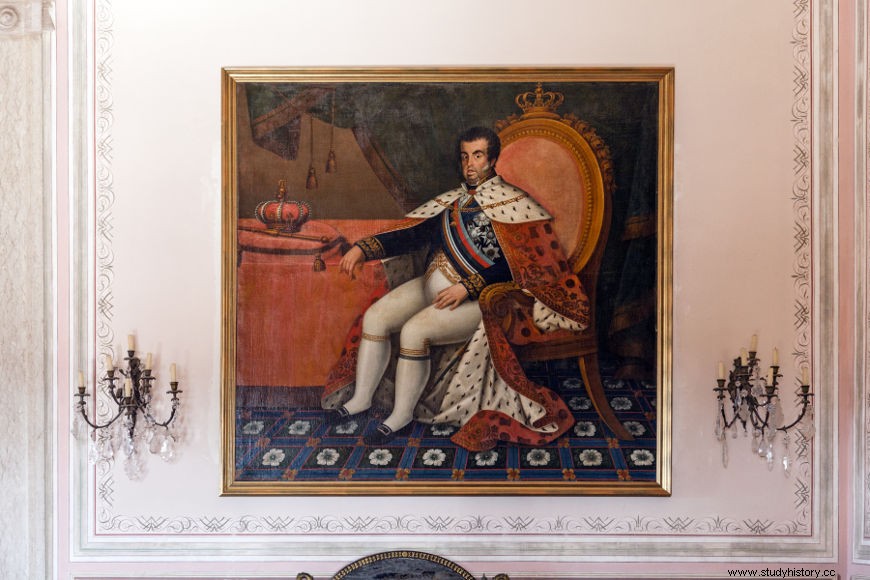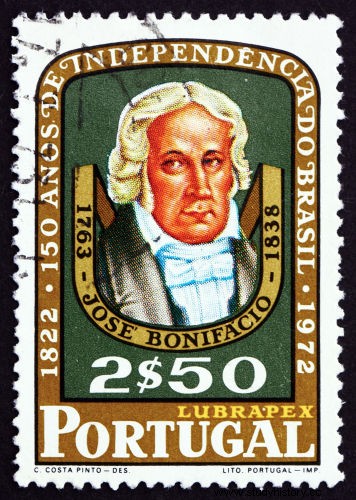The independence of Brazil was declared on September 7, 1822, and with it, Brazil determined the end of the colonial tie that existed with Portugal, declaring itself as an independent nation. The independence of Brazil was the result of a series of transformations that the country faced from the Johannine Period and had as great names Pedro from Alcântara and Joseph Bonifacio .
Also visit :The republican separatist movement that took place in the colonial period
Reasons for Brazil's independence

Brazil's independence had as its great starting point the Liberal Revolution of Porto, who had different intentions for Brazil than the Brazilian elite had. This divergence of interests caused this social layer to defend the idea of breaking the existing bond with the metropolis. Let's look at all the facts that led to this.
-
Transfer from the Portuguese Court and the Johannine Period
At the end of 1807, the Portuguese royal family decided to move to Brazil , due to the French invasion in retaliation for the fact that the Portuguese had breached the Continental Blockade. This transfer, which was actually an escape, caused the royal family to transfer the entire administrative apparatus from Lisbon to Rio de Janeiro.
The transfer of the Portuguese court to Brazil promoted a series of changes in the country. Now that the royal family was here, it was necessary to invest in the development of Brazil, and so, as a first step, d. João (who would only become D. João VI from 1816 onwards) decreed the opening of ports Brazilians to friendly nations.
In practice, this decision put an end to the commercial monopoly that existed and guaranteed to traders installed in Brazil the possibility of trading, for example, with England, the great commercial power in the world at the time. The partnership between Brazil/Portugal and England intensified when the Trade and Navigation Treaty was signed , in 1810, guaranteeing a tax reduction for goods brought by the English.
In addition to changes in the economy, the transfer of the court brought changes to culture and science, as universities were built , theatres and libraries , for example. The growth of the scientific and cultural scene in Brazil made it possible for important intellectuals and artists of that time to come to the country.
All these changes were made to transform Rio de Janeiro into a place capable of housing the court and all administrative institutions in Portugal. In addition to these significant changes, Brazil began to impose itself as an expansionist power in South America and, thus, Cisplatin and Guyana French were invaded by order of d. John VI.

After countless transformations, Brazil has yet to extremely important moment. In 1815, the country was raised to the status of a Kingdom, and Portugal was renamed Kingdom of Portugal , Brazil and Algarve . In practice, Brazil ceased to be a colony to become an entity equal to Portugal.
This measure can be seen as an interest of Portugal to prevent that any revolutionary impetus was developed here. This is significant because, in the 1810s, independence movements were popping up in the Spanish colonies, and Brazil still had other revolutionary examples, such as the United States.
Portuguese rule seemed to be assured, despite demonstrations of dissatisfaction, such as the Pernambuco Revolution of 1817. Everything changed when the Liberal Revolution in Porto began in Portugal in 1820.
Also visit :Could the abolition of slave labor in Brazil have happened before 1888?
-
Porto's Liberal Revolution
This was a revolution of a liberal character which began in Portugal a few years after the definitive defeat of Napoleon Bonaparte. The Portuguese bourgeoisie demanded reforms that put an end to the economic and political crisis that the country was facing and still wanted the end of absolutism. There was great dissatisfaction on the part of this class with the economic freedom conquered by Brazil during the Johannine Period.
With the outbreak of this revolution, the Portuguese Courts , an institution called upon to draft a new constitution for the country and to lead the necessary reforms. The Cortes immediately demanded that the Portuguese king, d. João VI, to return to Lisbon and for the commercial monopoly to be re-established in Brazil.
It was the Porto Revolution that started Brazil's independence process, as it demonstrated that the existing interests between the metropolis and the colony were irreconcilable.
Also visit :Understand how liberalism was applied in the economy
Brazil's independence process
The two demands of the Portuguese Courts logically had repercussions in Brazil, and a large part of this repercussion was negative. The pressure on d. João VI for his return was too great, and opinion in Brazil about it was divided. Regarding the second requirement (restoration of the commercial monopoly), the opinion in general was extremely negative, as it demonstrated the intention of the Portuguese courts to recolonize Brazil.
Pressed, d. João VI swore allegiance to the Portuguese Constitution in February 1821 and, in April, left for Lisbon with the Portuguese court. However, his son Pedro de Alcântara remained in Rio de Janeiro as Prince Regent of Brazil .
From then on, the relationship between Brazil and Portugal only frayed, starting with the performance of the Portuguese Courts and their relationship with the Brazilian representatives. The Portuguese demonstrated their intention to impose Lisbon's authority over all regions of the Portuguese Empire, and historians Lilia Schwarcz and Heloísa Starling still point out that the colonizers treated Brazilian representatives and Brazil itself with disdain.|1|
The intransigence of the Portuguese in their relationship with Brazilians meant that the willingness of the Brazilian elite to negotiate was transformed into resistance . With this, revolutionary agitation in Brazil began to increase and was driven by the Southeast's elite. Lilia Schwarcz and Heloísa Starling also point out that, between September and October, the relationship between Brazil and Portugal was worsened by measures determined by the Courts. These measurements were|2| :
-
Sending more Portuguese troops to Brazil;
-
Transfer of institutions from Rio de Janeiro to Lisbon;
-
Requirement of the return of the Prince Regent.
The reaction to d's return request. Pedro to Portugal was too big and negative, causing dissatisfied Brazilians to organize what became known as the Resistance Club . Hereby, a petition was organized against the return of d. Pedro to Portugal. The Prince Regent received this document with eight thousand signatures in January 1822.
This event ended up leading to Fico Day , which took place on January 9, and was an occasion when d. Pedro publicly announced that he would disobey the Portuguese order and remain in Brazil. To this day, historians are not sure of the speech given by d. Pedro, as there are discrepancies in the reports.
At that time, the defense of independence began to gain strength among Brazilian elites, although it was still the desire of many to find a path that reconciled the interests of Brazil and Portugal. The action of the Cortes, in turn, sealed the way and managed to unify most Brazilian provinces for independence.
In May 1822, it was decided that orders sent by Portugal would only be valid in Brazil through the personal approval of d. Peter, and this became known as the Fulfill it . In June a Constituent Assembly was convened, with the intention of drafting a Constitution for Brazil.

The independence process was carried out mainly by by José Bonifacio , since he managed to imprint many of his ideas in the decisions made and in the way they d. Pedro administered Brazil.
Finally came the official breakup. At the end of August, a letter with new orders from Portugal arrived in Brazil, and the tone remained harsh. The Cortes criticized Brazilian “privileges”, again demanded the regent's return and called José Bonifácio a traitor. This new letter made the wife of d. Pedro, D. Leopoldina, to call an extraordinary session which was decided by the independence of Brazil.
The news brought from Portugal and the decision of this extraordinary session were sent to d. Pedro. The regent was on his way to São Paulo, and the messenger named Paulo Bregaro reached the regent's entourage on September 7, 1822, on the banks of the Ipiranga River. Upon finding out about the situation, the conductor, supposedly, made the independence cry , also known as Scream from Ipiranga .
This event is considered the milestone of Brazilian independence. From there, a war of independence began. , as some provinces chose to remain loyal to Portugal. After a few years at war, the independence of Brazil was recognized by Portugal in 1824. In this period from 1822 to 1824, Brazil began to organize itself as an independent nation while defeating the provinces that were still loyal to Portugal.
Also visit :See the political practice of the nations that gained their independence from Spain
Brazil after independence
After independence, Brazil began to organize itself as a nation. The first decision to be made was the form of government to be imposed here, and our country decided to go against the grain of a large part of the American continent. Brazil chose to transform itself into a monarchy and not in a republic.
In South America, our country was the only one to become a monarchy, and in Latin America, besides Brazil, only Haiti and Mexico had monarchical experiences. As a monarchy, the country needed a monarch, and so d. Pedro was acclaimed and crowned Emperor of Brazil, becoming d. Pedro I .
The period that d. Pedro I ruled Brazil and became known as the First Reign, and his reign was marked by authoritarianism. A symbol of this was our first Constitution, which was granted (imposed) to fulfill the wishes of d. Pedro I. The emperor ended up resigning in 1831.
Notes
|1| SCHWARCZ, Lilia Moritz and STARLING, Heloisa Murgel. Brazil :a biography. São Paulo:Companhia das Letras, 2015, p. 209.
|2| Ditto, p. 210.
Image credits
[1] Commons
[2] StockPhotosArt and Shutterstock
[3] Boris15 and Shutterstock
Take the opportunity to check out our video lesson related to the subject:
